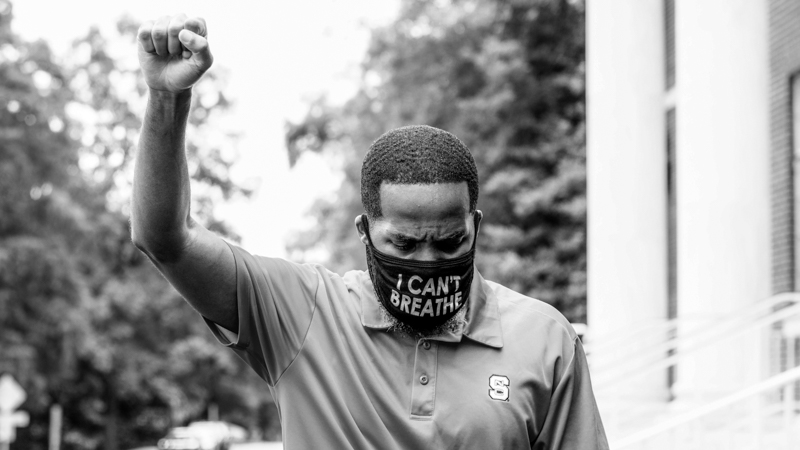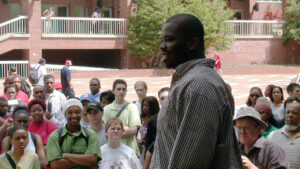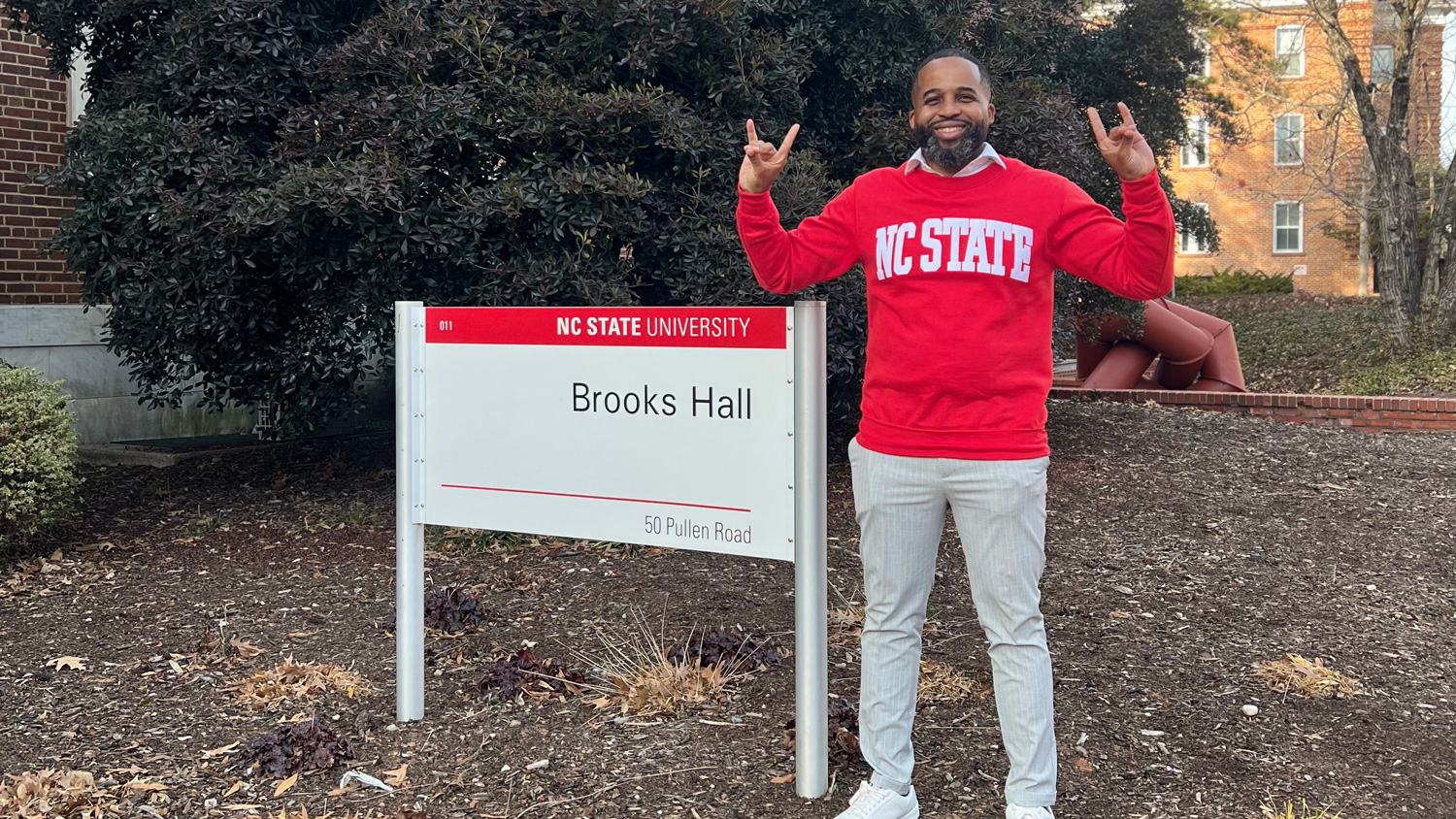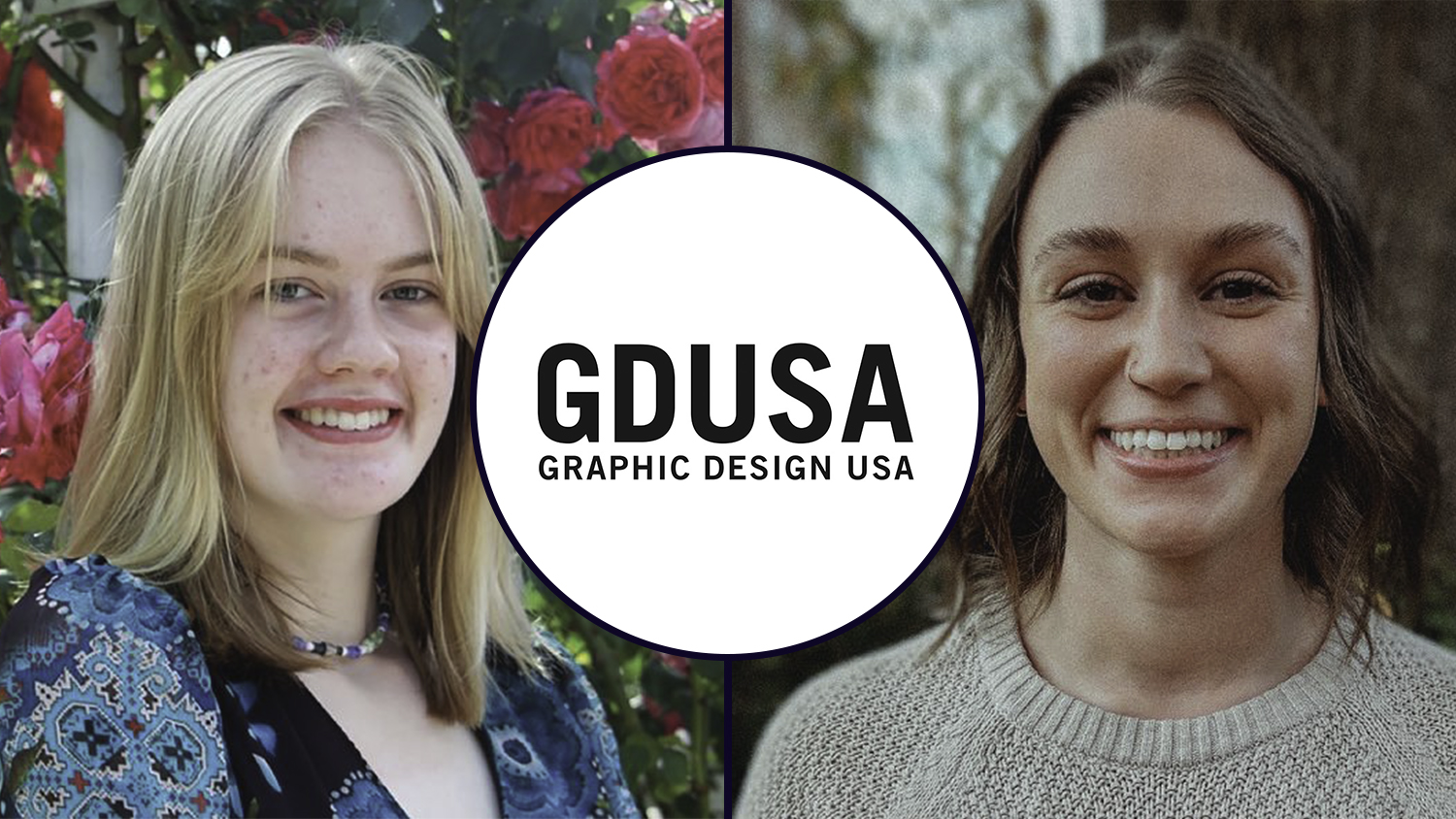Black Design Matters: A Q&A with Demarcus Williams
Demarcus Williams graduated from the College of Design in 2003.
He was the only Black student to graduate that year with a bachelor’s degree in Graphic Design, and one of seven Black students in his class accepted into the College of Design out of 120.

Demarcus Williams graduated from the College of Design in 2003.
He was the only Black student to graduate that year with a bachelor’s degree in Graphic Design, and one of seven Black students in his class accepted into the College of Design out of 120.
The current spotlight on systemic racism and police brutality has not only catalyzed a national conversation but also focused attention on more complex issues surrounding Black life in various communities.
During his time at NC State, he played an active role in protesting racism on campus. Today, he is harnessing that same activist spirit to combat discrimination and bigotry in North Carolina.
He currently works as a Graphic Design Manager & Social Media Specialist at Saint Augustine’s University in Raleigh, and also owns and operates FreshDesignz, LLC. Demarcus also spent seven years as an adjunct typography instructor at Wake Tech Community College.
We started our discussion with Demarcus after he shared his own experiences with racism on NC State’s campus in 2002 when a white student told his friend and classmate to “go back to Africa.”
He was also recently interviewed during a protest in June.
Race, Education and Design with Demarcus Williams
Let’s start with a bit about your background and what inspired you to get into design.
I was first introduced to design and the creative field when I was four. My mom would buy me pencils, paper – I would just draw and sketch every day.
My mom pushed me into art shows, and I participated in an event back in the 80s called Cultural Arts, which was an arts competition for elementary school students where you submitted paintings and sketches.
As I got older, I started having my work put into malls and the principal’s office – things like that. I was always in art classes. By the time I got to high school, I started thinking more about design. But the only field that I knew of that I could have a corporate-type job in using my artistic skills was architecture.
I was accepted into the College of Design as an architecture major. But when I was in my design fundamentals studio, I began to learn more about different disciplines in design. I learned that graphic design was probably the best fit for me to marry my interests in both creative arts as well as technology.
When you were first getting introduced to the various aspects of design before college, who or what were some of your inspirations?
In high school, I had some really good art teachers that pushed me. In terms of my studies and my research, I started learning about black artists like Jacob Lawrence, Henry Ossawa Tanner – artists in the Harlem Renaissance age. I’ve used their styles in some of my work, and in my portfolio to get into the College of Design.
How did you choose the College of Design, and what were some of your first impressions when you got in?
My first impression on the College of Design was that it was like making it to like the NBA, because of how competitive the program was – you had an interview process, you had a portfolio review – there were several steps that you had to go through just to get in. They really made it a point to tell you from the time that you got in that it really meant something to be a part of the College of Design. There were only seven Black students that got admitted out of 700 applicants. They winnowed it down and they accepted about 120 students. Out of those 120, only seven were Black.
Immediately, we got really close – all in different disciplines. I don’t want to say culture shock, but it was definitely an experience.
But we had a very strong support system. What helped in that process, at least as a Black student, was that back then, NC State had an office called African American Student Affairs (now Multicultural Student Affairs) led by Dr. Tracey Ray (now Robinson) and Stacia Solomon. They had a program called African American Symposium, which was like a pre-orientation for Black students. The African American Cultural Center led at the time by Dr. Iyailu Moses and Ms. Toni Thorpe, also played a huge part in instilling in us the cultural awareness as a Black student at NC State.
Through both programs, you were educated on the culture of NC State as a whole and the importance of using your resources. Current Black students would come talk to you, share information, and give you some tips on how to best navigate through NC State. Going in that way was really helpful on that first day of class. Marva Motley, who at the time was the Associate Dean of Student Affairs for the College of Design was like a mother to many of the Black students in the College and helped me tremendously in acclimating to the program as a freshman.

Was there something in particular that stuck with you about being a Black student at a predominantly white institution (PWI)?
One of the most memorable things that I gained from attending African American Symposium was that the students encouraged each of us to make sure that we spoke to every Black student that we saw on campus. And that may seem kind of minor, but what they were trying to teach us is that we’re a community within the university. Many of us, even though we might have been in different colleges and different departments, we were all very much a minority.
Just by speaking to another Black student, you identify with them like, “I see you. I can relate to you. I understand what you’re going through.”
They also strongly encouraged you to use the resources at NC State. As a large, predominantly white institution (PWI), it is blessed with a robust amount of resources. Part of our responsibility as students is to be successful, so we had to take advantage of the tutors, the library – all the systems that were in place at that time. It’s all at your disposal.
The African American Student Affairs also had a peer mentor program, and they always encouraged us to make sure that we were mindful of the friends that we had, because that would reflect your GPA. They made us aware that there will be times where you may encounter some form of racism, but also you knew that you have a family here.
Can you talk about your journey as a Black designer?
Part of the culture at PWIs is that if you showed any type of intellectual capacity or if you showed yourself to be a hard worker, there was an element of tokenism. It’s like being told, “Well, we like you. You’re okay. But we’re just not sure about them.” The problem is, when I go somewhere else, I am one of them.
The concept of tokenism is really dangerous because it gives you a false sense of security. It makes you feel like you are okay in an environment where at any time you could not be okay. For some of the Black students who may not have been as self-aware, it created a lot of unnecessary competition for approval to be the next token.
It’s like being told, “Well, we like you. You’re okay. But we’re just not sure about them.” The problem is, when I go somewhere else, I am one of them.
I came from a middle-class background, but because I was Black, even when I was in high school, a lot of people assumed I was from the hood just because a lot of my classmates were from the hood. That’s why it’s important to hear the perspectives of all Black students because we all come from different places. A lot of us are from rural places, from urban places, some of us were from more well-to-do backgrounds, some of us from very poor backgrounds. We all came together to have one experience at NC State.
Tokenism is a big issue. When you look at what’s happening with police brutality, the victims involved are just every-day people who probably had great relationships with other white folks. If you asked their white co-workers, they would have thought that they were great people.
But that doesn’t mean a lot when you get pulled over by the police. The police don’t know who you are. Even though being the token can seem complimentary at first, it can be very dangerous, and in some ways racially insensitive to people of color. The concept of being “colorblind” is really not a fair assessment of race relations.
To be colorblind is to say that you’re not acknowledging or embracing the differences that we have, and what we can bring to the table. I think it’s important that we do see color and recognize it for what it is, so that we can find ways that we can grow together in spite of our differences.
The experience for the Black student goes even further. The experience of the Black faculty member, the experience of the Black administrator, the experience with a Black staff member – they experience tokenism. They experience uneven pay. They experience being placed in a position just to satisfy the appearance of diversity. But there’s really no interest in empowering them or allowing them to have the ability to make decisions.
As a Black professional in a predominantly white corporation or institution, a lot of times as the token, you’re there just to show that the organization has some type of commitment to diversity, but you’re not there for your voice. That can be very discouraging.
What was your first step after graduating from the College of Design and going into the professional world?
When I graduated from NC State in 2003, there was a recession going on. Just like a lot of people back then, I was applying to a bunch of jobs, but nobody was really hiring.
There was one job out in DC that an alum was working at. They told me that they couldn’t hire me, but they did have some projects for me to do. That’s how my freelance business got started. Since I was freelancing, working these odd jobs, I finally ended up landing my first job in my field at a print shop on Wilmington Street in downtown called Turner Printing Services.
I was just doing pre-press work and delivering copies to law firms. It wasn’t the most fun job, but that was my introduction to the nine-to-five in my field. I eventually ended up working at another company called Progressive Business Solutions to do some printing, but I also got a chance to do design. It was actually a Black-owned business where I was able to consult with clients and manage the design and print processes from start to finish. That experience really shaped my professional and business career from then on.
Were there similarities between being a Black student and a Black professional?
Yeah, there were some. When I was on my way out of NC State, I was really starting to lean in more on just doing little side projects for some of my classmates and friends for different things.
I remember telling myself that my dream would be to use my talents to help Black businesses succeed. That kind of led to my experience as a freelancer where about 99% of my clients are Black. That has been a very fulfilling experience for me, because I was able to use the education and professional skills that I learned at NC State to really help create quality work for clients that otherwise may not get that.
Did you find similar support from the Black professional communities in the creative world as you did at NC State?
Yes. There are some groups on Facebook for designers, but there are several just in the Triangle. I’ve been blessed to be a part of the Greater Durham Black Chamber of Commerce. There’s also the North Carolina Institute of Minority Economic Development. There are several organizations that I’ve gotten several leads from. Just with the connections that I’ve made in the area, I’ve been very fortunate to work with a lot of clients.
Right before I graduated from NC State, I reached out to Black Enterprise Magazine in New York, one of the premier magazines in the country as it pertains to Black business and Black lifestyle. I just asked if I could speak to the creative director – I wanted to have an informational meeting with him and show him my portfolio. I spoke with him over the phone and sent him my website, some samples, my work, he replied back and was like, your work is great, you have superior talent.
He ended up becoming one of my mentors over the years. That connection led to me one day putting an illustration in one of their issues.
Were there any professors at the College of Design that you would consider role models who inspired you to take on certain projects or focus your creative talents and skills?
I would say, first and foremost, Kermit Bailey, hands down. He was the only Black professor in graphic design. He was hard on everybody, but he was really hard on me. He was brutally honest. He pushed me. I remember he used to sit me down and say, “Demarcus, when you get into those critiques, you’ve got to kick butt and take names.”
He really pushed me, and looking back on it, I really wish that I had bought into some of the things that he was trying to teach me earlier. I didn’t really fall in love with design until maybe my senior year. I was still so interested in all the extracurricular activities at NC State, with the frat life, and the party life and the social life – all those things. The College of Design just doesn’t have a lot of room for that. At the College of Design, you find out if you really love design. You learn really quickly if this something that you love to do.
Do you have any words of advice or personal insights that you want to share, especially for future Black designers or designers of color?
First, apply to NC State.
The second thing I would say is take advantage of your resources. Find the balance between embracing the family that you have of other Black students, as well as immersing yourself in the academic community at the College of Design.
I was the only Black student in my class in graphic design. I was the only Black student to graduate with a bachelor’s degree in graphic design in 2003. It was a lonely road. But because I did have a strong support system outside of the college, as well as the other Black students in the other disciplines within the college, it was very helpful getting through this.
Regarding the incident I posted about on Facebook – the NC State Black community was like a family. When a white student told one of my friends, Najja Baptist, to go back to Africa because he was expressing his issues with race at NC State and in America – it didn’t take a lot for us to mobilize.

This was something that had been brewing for a long time. I mean, from some of the racially insensitive articles that were posted in the Technician to how custodians and cafeteria workers who were all Black back then were being disrespected by white students. We all felt like we were in the same boat. All of us at some point in time had experienced something very similar.
While some of those situations may be uncomfortable as a student, you can still use them as opportunities. I used my skills and the things I was learning in studio to establish a dialogue on race. I made a website, I took pictures, I recorded videos and I even had some of my classmates who were white participate and share why they felt it was important to speak out against racism.
NC State is not an HBCU. It never will be – and there’s nothing wrong with that. But Black students who decide to go there can still have a great experience. I can say that being a Black student at NC State, even with some of the things that took place there, they were some of the best years of my life.
The racial demographics at NC State and the programs that are currently in place for Black students are much different from when I was there. To see the Chancellor’s remarks in response to George Floyd, to see how the university responded to students using racial slurs online – students did stuff like that all the time back then.
To see the university as an institution that is taking more intentional steps to protect all of its students is very encouraging. Change doesn’t happen overnight, but it’s encouraging to see those steps being taken to move forward.
A Call for Voices
The goal of this interview is to be the first of many. Not only to highlight and celebrate the accomplishments of Black students at the College of Design but also to paint an honest, raw and authentic picture of the Black experience in the creative professions our students aspire to succeed in.
Establishing a platform that educates the public and provides the necessary resources to ensure equity and inclusion in design can only occur when we begin an open, transparent dialogue at our college.
If you are a Black alumnus/alumna, a current student, a staff member or a faculty member who is interested in sharing your experience, please contact Max Cohen at max_cohen@ncsu.edu to start the conversation.
*Cover image by Angela Harbison of Eclecta Creative Group
- Categories:


